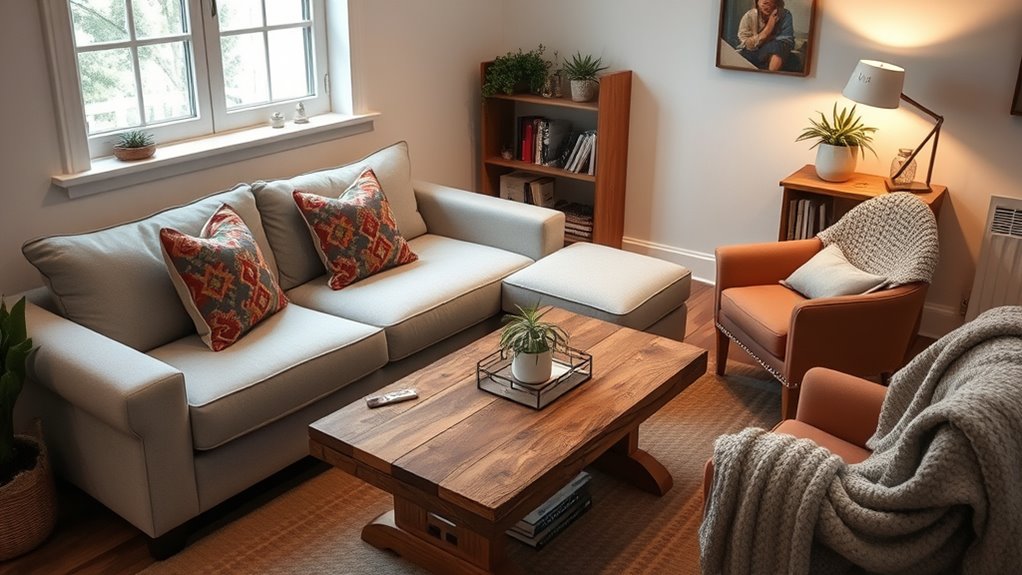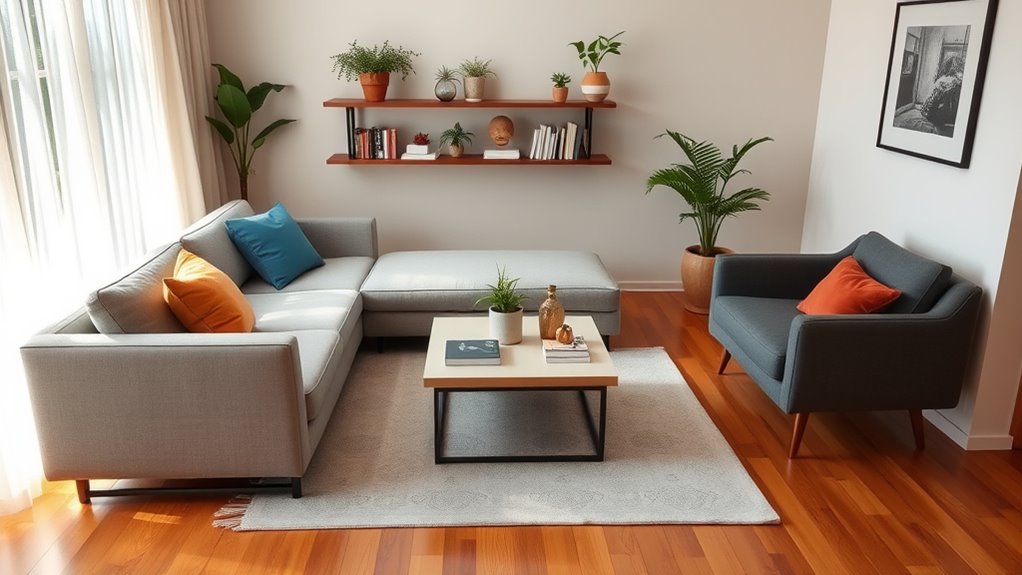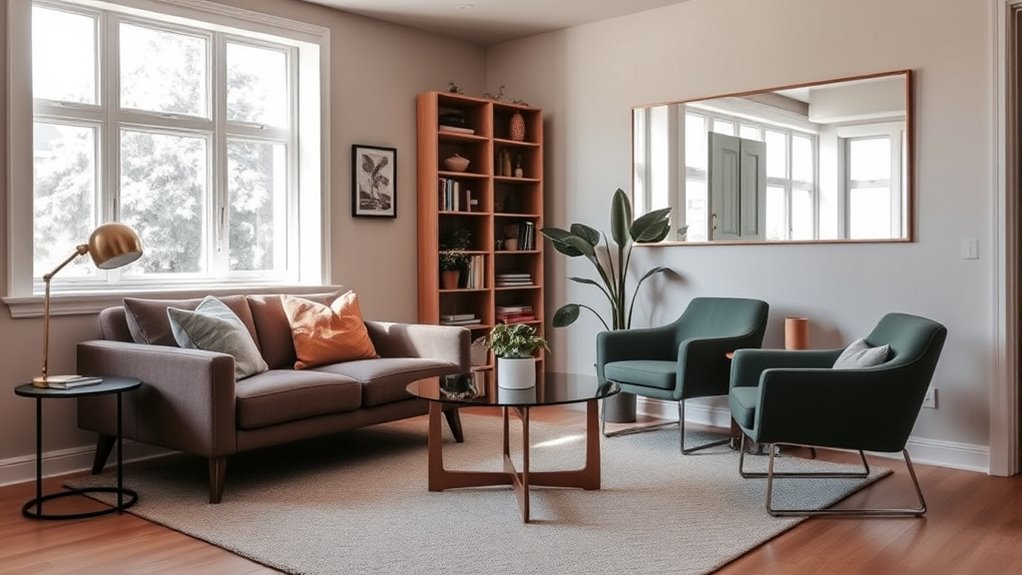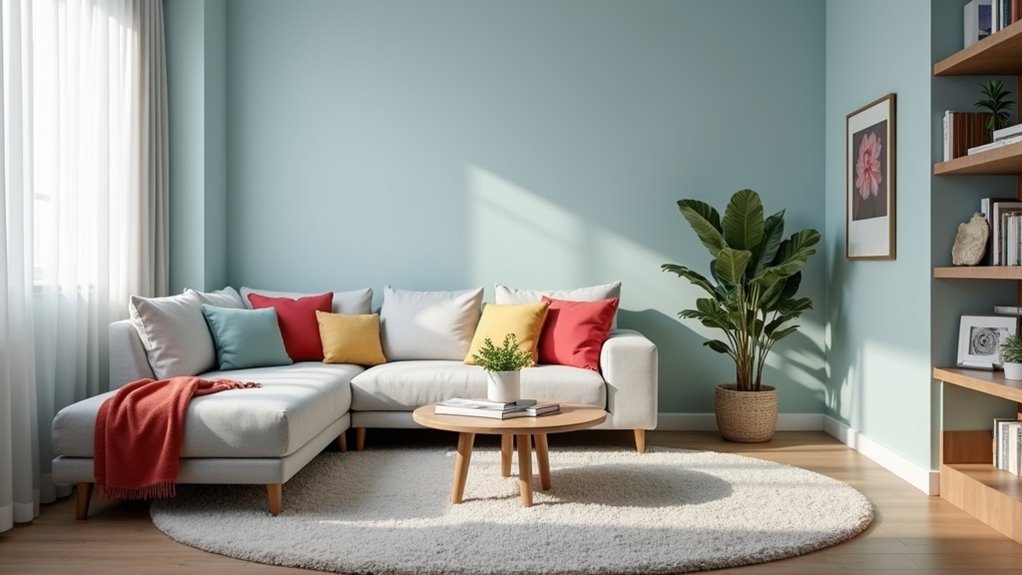To arrange furniture in a small living room, start by identifying a central focal point like a fireplace or art piece. Create cozy conversation areas with L-shaped or circular seating, and use area rugs to define zones. Opt for multi-functional furniture, like ottomans with storage, to save space. Maximize natural light by keeping windows clear of obstacles and using sheer treatments. Remember to leave clear traffic paths for easy movement. You’ll discover more tips that can transform your space soon!
Key Takeaways
- Identify a focal point like a fireplace or artwork, and arrange seating to enhance engagement around it.
- Create cozy conversation areas by positioning sofas and chairs in circular or L-shaped formations, using area rugs for definition.
- Utilize multi-functional furniture, such as ottomans with storage or coffee tables that convert into workspaces, to save space.
- Maximize vertical space with tall shelves and light-colored decor, and opt for small-scale furniture to maintain an airy atmosphere.
- Ensure clear traffic paths by leaving 24-36 inches of clearance and arranging furniture to guide movement around conversation areas.
Identify a Focal Point

When you’re arranging furniture in a small living room, identifying a focal point is essential, as it creates a central visual anchor for the space.
Choose something that resonates with you, like a fireplace, television, or a striking piece of artwork. Position your seating arrangements to face or surround this focal point, ensuring everyone can enjoy the view and engage in conversation. To enhance its impact, use complementary colors or decorative elements that draw attention, adding visual interest to the room. Remember to select a focal point that’s proportionate to the space, avoiding oversized features that may overwhelm it. Additionally, consider incorporating functional design elements that not only accentuate the focal point but also improve the overall flow of the space. Understanding space functionality is crucial for maximizing usability and comfort in small living areas. A well-chosen focal point can also enhance quality of life by creating a welcoming atmosphere that encourages social interaction. Moreover, integrating luxury travel inspiration can bring a touch of elegance to your decor, elevating the overall ambiance of your living room.
Finally, consider how you’ll use the area daily, aligning the focal point with your lifestyle for maximum comfort and usability.
Create Cozy Conversation Areas

Once you’ve established a focal point in your small living room, the next step is to create cozy conversation areas.
Arrange your sofas and chairs in a circular or L-shaped formation to foster an inviting atmosphere. Use small-scale, lightweight furniture to maintain a cozy setting without overwhelming the space, allowing easy movement and interaction. Additionally, incorporating innovative design ideas can enhance the overall aesthetic of your living area. For instance, experimenting with smart furniture solutions can maximize functionality while keeping the space feeling open. Consider adding large indoor plants to improve air quality and create a more inviting atmosphere.
Incorporate area rugs to define your conversation area, ensuring the rug is large enough to accommodate all seating for a cohesive look. Position your seating to face each other, encouraging dialogue and connection among occupants.
This layout not only enhances comfort but also makes every gathering feel intimate and engaging, turning your small living room into a warm haven for conversation. Additionally, a clean home can reduce allergens and pollutants, contributing to a healthier environment for you and your guests.
Utilize Multi-Functional Furniture

When space is tight, multi-functional furniture is your best friend.
Look for pieces that serve dual purposes, like ottomans with storage or coffee tables that can transform into workspaces. Electric fake fireplaces are also a great addition, providing ambiance without taking up much space. These versatile designs not only save space but also enhance the functionality of your living room. To support your family’s needs, consider choosing furniture that accommodates caregiving responsibilities while maintaining style. Additionally, incorporating natural elements into your decor can help create a calming atmosphere that complements the farmhouse aesthetic. To achieve a cohesive look, consider incorporating textures like wood and fabric that align with the farmhouse aesthetic.
Space-Saving Solutions
Maximizing space in a small living room doesn’t have to be a challenge, especially with the right multi-functional furniture. Consider incorporating items that serve dual purposes to enhance your space-saving solutions. Here are some great options:
| Furniture Type | Functionality | Benefits |
|---|---|---|
| Ottoman | Seating & Storage | Reduces clutter |
| Coffee Table | Built-in Storage | Keeps essentials handy |
| Sofa Bed/Futon | Seating & Sleeping | Accommodates guests |
These choices adapt seamlessly into small living room layouts, providing both functionality and style. Opting for folding furniture can also make rearranging a breeze, ensuring you maximize every inch of your space without feeling cramped. Additionally, incorporating natural materials can enhance the aesthetic appeal of the room while maintaining a cozy atmosphere. Consider adding cozy textiles to create a welcoming environment that complements your space-saving solutions. Furthermore, a well-organized space promotes mental clarity, allowing you to fully enjoy your small living area. To further enhance the comfort of your living area, layer lighting with ambient, task, and accent sources to create a warm and inviting atmosphere.
Versatile Design Options
To create a functional and stylish small living room, consider the power of versatile design options. Multi-functional furniture is key to achieving an efficient small living room layout.
Look for ottomans that provide both seating and storage, keeping your space clutter-free. A coffee table that doubles as a work surface or dining table can easily adapt to your needs, especially models with extendable features. Basic carpentry can be a useful skill if you want to customize your furniture to fit your unique space requirements. Additionally, a cohesive color palette can enhance the overall aesthetic of your living room while maintaining the functionality of your furniture. When selecting your furniture, it’s beneficial to explore appliance retailers that may offer stylish and affordable options for small spaces.
Incorporating a sofa bed or futon optimizes functionality, offering comfortable seating by day and a sleeping space for guests at night. Nesting tables offer flexibility, as they can be moved or tucked away to conserve floor space.
Finally, wall-mounted shelves or foldable desks enhance usability without sacrificing valuable square footage. Additionally, consider including a heated mattress pad for enhanced comfort during cold evenings, which can significantly improve your overall living space experience.
Optimize Natural Light

To optimize natural light in your small living room, position your furniture wisely around windows. Choosing sheer window treatments can enhance sunlight while preserving privacy. Incorporating responsive design in your living space can further create an inviting atmosphere that maximizes brightness. Additionally, ensuring proper airflow around the unit can improve the overall air quality, making the space feel more open and refreshing.
Maximize Window Placement
Natural light can transform a small living room, making it feel brighter and more open. To maximize window placement, follow these tips:
- Position furniture away from windows to allow light coming in to flow freely.
- Use light-colored or sheer window treatments that filter light while ensuring your privacy.
- Arrange seating areas near windows for a cozy spot to read or relax, connecting you to the outdoors.
- Avoid tall furniture or large decor items in front of windows, as they obstruct light and lessen spaciousness.
Incorporating reflective surfaces like mirrors can also help bounce light around the room, enhancing the overall brightness and welcoming atmosphere you desire.
Choose Sheer Treatments
Sheer window treatments are a fantastic choice for maximizing natural light in your small living room while still maintaining privacy. By choosing sheer curtains, you allow sunlight to filter through, brightening your space and creating an airy atmosphere.
Opt for light-colored fabrics, as they reflect light better than darker materials, enhancing the room’s luminosity. Hanging sheer drapes close to the ceiling can draw the eye upward, giving the illusion of higher ceilings and making the area feel more expansive.
Additionally, select lightweight sheer treatments that can be easily adjusted, allowing you to control light and maintain a comfortable ambiance throughout the day. Embracing sheer treatments truly helps your small living room feel larger and more inviting.
Maximize Vertical Space

Maximizing vertical space is key to making a small living room feel more expansive and inviting. By utilizing the height of your room, you can create visual interest and enhance the overall aesthetic.
Here are some effective strategies:
- Install built-in or DIY bookshelves that reach the ceiling for ample storage and to draw the eye upward.
- Hang draperies high above windows to create the illusion of taller ceilings, making the room feel airier.
- Incorporate tall shelves and oversized lamps to add verticality and break up the cramped feel.
- Use light-colored decor on vertical surfaces to reflect light and maintain an open atmosphere.
These tips will help you maximize vertical space in your small living room, making it feel more spacious.
Define Zones With Area Rugs

Creating defined zones in a small living room can transform the space into a more functional and inviting area.
Area rugs are an effective way to define zones for different activities, like lounging or working. Choose a rug that’s large enough for the front legs of your seating to create a cohesive look. Opt for solid-colored rugs or those with subtle textures to avoid visual clutter while still marking distinct areas.
Layering rugs can introduce depth, allowing you to mix patterns without overwhelming the room. Position rugs to partially overlap with furniture to anchor your seating and enhance the flow, ensuring each zone remains clear and inviting in your small living room.
Choose Appropriate Furniture Scale

Choosing the right scale of furniture is essential for making a small living room feel open and inviting. You want to select pieces that won’t overwhelm the space. Here are some tips:
- Opt for small-scale furniture that maintains an airy atmosphere.
- Choose lightweight, minimalistic designs with smooth lines and legs to enhance visual flow.
- Consider pairs of accent chairs instead of a bulky sofa to maximize seating and encourage conversation.
- Incorporate multi-functional furniture, like ottomans that double as storage, to keep your living area organized.
Always ascertain your furniture is proportionate to the room’s dimensions—oversized items can dominate the layout and hinder functionality.
Balance is key to creating a comfortable environment.
Establish Clear Traffic Paths

While arranging furniture in a small living room, it’s crucial to establish clear traffic paths to guarantee smooth movement throughout the space. Aim for a minimum of 24-36 inches of clearance for walkways, allowing easy navigation around your seating.
Arrange your furniture to direct traffic around conversation areas rather than through them, fostering intimacy. Position pieces to create defined paths from entry points to focal points, enhancing flow.
Use armchairs or small side tables to mark the edges of seating areas, guiding traffic and adding structure. Avoid placing large furniture in high-traffic zones to prevent congestion and maintain accessibility.
Frequently Asked Questions
How to Layout Furniture in a Small Living Room?
When you layout furniture in a small living room, start by identifying a focal point, like a TV or fireplace.
Arrange your seating to face this element, creating a cozy gathering space. Pull furniture away from walls to encourage conversation, clustering sofas and chairs around a coffee table.
Use multi-functional pieces to save space, and define areas with rugs.
Finally, guarantee clear paths for movement to keep the space accessible and inviting.
What Is the 2/3 Rule Furniture?
The 2/3 rule in furniture arrangement suggests you should use about two-thirds of your available space for furniture, leaving one-third open for flow.
This balance keeps your room from feeling overcrowded while ensuring that furniture pieces complement each other. By following this guideline, you’ll create designated functional areas without sacrificing accessibility.
It encourages you to choose well-fitting, multi-functional pieces, making your space feel organized and inviting while still allowing room to move freely.
What Are the Four Rules in Furniture Arrangement?
When arranging furniture, focus on four key rules.
First, establish a focal point to guide your layout.
Next, create clear traffic paths to guarantee easy movement.
Third, group furniture for intimacy, pulling pieces closer together to foster conversation.
Finally, use multi-functional pieces to maximize space, opting for items that serve more than one purpose.
These strategies will help you craft a functional and inviting environment, no matter the size of the room.
Should a Couch Be Against the Wall?
Imagine stepping into a room where the couch invites you in rather than pushes you away. You might think a couch should be against the wall, but pulling it slightly into the space creates a cozy nook, fostering conversation and connection.
Conclusion
By following these furniture arranging fundamentals, you can transform your tiny living room into a stylish sanctuary. Focus on a fabulous focal point, foster friendly conversation zones, and favor functional furnishings. Don’t forget to draw in delightful natural light and dominate vertical space for a dynamic design. With a little creativity and clever planning, your small space can feel spacious and sophisticated, making it the perfect place to relax and rejuvenate. Happy decorating!









